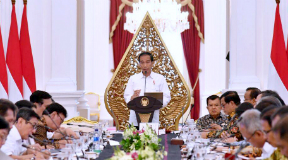
DKI Jakarta Governor Anies Baswedan (left) with President Joko Widodo. (Photo: Wahyu Putro/antaranews.com)
When the election results are tallied in a few weeks’ time, one counting will be critical. Aside from the national tally for the presidential race, the outcome in Jakarta will show whether President Joko “Jokowi” Widodo can take back the city from Anies Baswedan, the current governor. This is a crucial race for the incumbent president, both in a personal and political dimension.
Jokowi first won the city’s governorship in 2012 and had major support in the capital in the 2014 presidential election. He left the city in the care of his vice-governor and close ally, Basuki “Ahok” Tjahaja Purnama. In a contentious gubernatorial race in 2017, Ahok lost to Anies, marking the watershed moment for both Jokowi’s political fortunes and Indonesian politics in general.
The 2017 gubernatorial election was very much a continuation of the political rivalry between the Jokowi-Megawati alliance and Prabowo Subianto and his coalition partners in the 2014 presidential election when Jokowi won. In the gubernatorial race, Anies was Prabowo’s surrogate.
Looking at Jakarta’s voter dynamics in the 2014 presidential race and the two-stage 2017 gubernatorial election revealed how each of them was perceived and received by the communities at subdistrict level, and it could become the baseline in anticipating the outcome of next week’s election.
In 2014, Jokowi edged his opponent by around 6 percentage points in the capital or about the same margin as the national outcome. He secured some 2.8 million votes against 2.5 million for Prabowo and was ahead in three of Jakarta’s five municipalities. He garnered the largest support from the west, followed by the northern region and central district. Prabowo scored well in the eastern part of the city and won narrowly in the southern corner.
With such substantial ground and a relatively comfortable approval rating, Ahok and Jokowi were optimistic when they entered the Jakarta race in 2017. In a three-way race — which was contested by Ahok, Anies and Agus Harimurti Yudhoyono — no one secured an outright win, which resulted in a runoff between Ahok and Anies.
Despite leading in the first-round of balloting, a telltale sign of weakness in Ahok’s support emerged. By garnering some 2.35 million votes, he underperformed by a sixth when compared to Jokowi in 2014 — a loss of more than 500,000 votes. He lost ground in all subdistricts in the capital at about the same rate. He only won in areas where Jokowi was ahead in the north, west and central districts, but it was still below what the President garnered.
A similar fate befell Anies. In that first-round, he also had a deficit compared to what Prabowo gained in 2014. However, with almost 335,000 votes it was not as steep as Ahok’s loss.
That loss was Agus’ gain. A correlation analysis reveals that he lured those who voted for Jokowi and Prabowo in 2014 from their respective surrogates, especially in East Jakarta — from Anies — as well as South and West Jakarta from Ahok. He did expand his voter base slightly, and garnered almost 1 million votes.
Ahok’s supporters were steadfast. They voted again for him in the second round. But for no one else.
Had those who voted for Jokowi in 2014 but voted for Agus in 2017 returned to vote for Ahok in the second round, the Jakarta election would have been close indeed. Instead, those who voted for Agus in the first-round broke ranks to cast their ballots for Anies.
With such an overwhelming break, Anies led by 16 points, which was more than Jokowi could muster in 2014. He flipped the central district and, most crucially, expanded his base in eastern and southern Jakarta. Albeit narrowing the gap with Jokowi’s base in 2014, Anies still could not catch up in the western and northern suburbs.
Predictably, Anies’ support increased in the Muslim-conservative corridor of Jagakarsa-Pasar Minggu-Mampang Prapatan-Pancoran-Tebet, in the southern district. Moreover, he swung the more diverse subdistricts of Cilandak, Kebayoran Lama and Pasanggrahan with a clear run in the last two. Only in the elite suburb of Kebayoran Baru did he fall short of overtaking Jokowi’s 2014 number.
The eastern suburbs were where the gap was far and wide. With support from Agus voters — and some more — Anies reigned supreme in all 10 subdistricts with almost 1 million votes. While Prabowo in 2014 was leading by 7 points against Jokowi, Anies surged to 24 points ahead of Ahok in the 2017 final round. Some 280,000 votes separated Anies’ number from Jokowi’s 2014 result in the largest district in Jakarta.
The northern district was a mixed bag. While Anies held the edge in 2017, his numbers still fell short of Jokowi’s in 2014 by about 50,000. He could not break into the subdistricts of Pademangan, Tanjung Priok, Penjaringan and Kelapa Gading. But he managed to swing Koja and Cilincing — two large suburbs — his way.
Anies also fell short in the western side where the President’s number was some 55,000 more. But he took the three-suburb corridor of Palmerah-Kebon Jeruk-Kembangan, and almost flipped the adjacent Kalideres. However, Anies could not take Taman Sari, Tambora, Grogol Petamburan and Cengkarang.
With stronger roots in the northern and western suburbs, there is a path for Jokowi to reclaim the city that he once led.
First, he needs to convince the solid Ahok voters — some 2.3 million people — to turn out on April 17. A concerted effort in all five districts is required to canvass and guide them to the polling stations.
Then, those voters who bolted to support Agus in 2014 — and later Anies — need to be reengaged and invited back into his coalition. If they have left because of the contentious identity issues in 2017, it would fall on Ma’ruf Amin, Jokowi’s vice-presidential candidate, to woo this constituency. In addition, this grass root effort should also aim to expand the supporter base by targeting new voters and Prabowo-Anies voters.
Reclaiming the subdistricts in the northern and western districts is essential in building the foundation, together with retaking the central district. From these bases, securing the outer subdistricts of South Jakarta would then further strengthen his path. The next step is to chip away at voters in the Tebet to Jagakarsa corridor and Prabowo’s bastion in the east.
In any case, the outcome could be telling. If Jokowi fails to retake the city from the Prabowo-Anies, it will show that their coalition has solidified. What would also be crucial is whether Ahok voters — the bulwark of Indonesia’s tolerant and pluralistic politics — will remain.
The ball is in Jokowi-Ma’ruf’s court, while Prabowo-Sandiaga-Anies are playing defense.
Adi Abidin and Piebo Dimas Perdana. Adi Abidin is a research fellow at Populi Center and Piebo Dimas Perdana is a public affairs consultant at Kiroyan Partners. The views expressed above are their own.
Source: The Jakarta Post, April 11, 2019, page 6.



